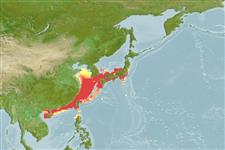Environment: milieu / climate zone / depth range / distribution range
Écologie
marin récifal; profondeur 20 - 200 m (Ref. 5222). Tropical; 38°N - 18°N, 108°E - 142°E (Ref. 5222)
Northwest Pacific: Korea, Japan (north to Hegura-jima Island), China (south to Hong Kong and Hainan Island), and Taiwan.
Length at first maturity / Taille / Poids / Âge
Maturity: Lm ?, range 54 - ? cm
Max length : 136 cm TL mâle / non sexé; (Ref. 89707); common length : 60.0 cm TL mâle / non sexé; (Ref. 9137); poids max. publié: 33.0 kg (Ref. 40637)
Épines dorsales (Total): 11; Rayons mous dorsaux (Total): 13-15; Épines anales 3; Rayons mous anaux: 8. Distinguished by the following characteristics: adults dark greyish brown; body covered with small pale grey spots forming short horizontal lines and mottled pattern; lower margin of the anal fin and lower corner of the caudal fin with white edge; juveniles pale yellowish brown, body with 6 irregular oblique dark bars containing irregular pale spots; elongate body, depth 3.0-3.6 times in SL; head length 2.3-2.5 in SL; convex interorbital area; angular preopercle, serrae at angle distinctly enlarged; inconspicuous dorsal spine on opercle; convex upper edge of operculum; small and subequal posterior and anterior nostrils; maxilla reaching past vertical at rear edge of eye, tiny embedded scales on maxilla; absence of step on ventral edge of maxilla; 2 rows of well-developed canines on midlateral part of lower jaw; caudal fin rounded; mid-lateral body scales ctenoid, without auxiliary scales on body (Ref. 089707).
Inhabits rocky reefs; also found on muddy grounds (Ref. 089707). Juveniles occur in shallow waters. Commercially cultured in Japan.
Life cycle and mating behavior
Maturité | Reproduction | Frai | Œufs | Fécondité | Larves
Heemstra, P.C. and J.E. Randall, 1993. FAO Species Catalogue. Vol. 16. Groupers of the world (family Serranidae, subfamily Epinephelinae). An annotated and illustrated catalogue of the grouper, rockcod, hind, coral grouper and lyretail species known to date. Rome: FAO. FAO Fish. Synop. 125(16):382 p. (Ref. 5222)
Statut dans la liste rouge de l'IUCN (Ref. 130435)
Menace pour l'homme
Harmless
Utilisations par l'homme
Pêcheries: commercial; Aquaculture: commercial; pêche sportive: oui
Plus d'informations
RéférencesAquacultureProfil d'aquacultureSouchesGénétiqueElectrophoresesHéritabilitéPathologiesTraitementNutrientsMass conversion
CollaborateursImagesStamps, Coins Misc.SonsCiguateraVitesseType de nageSurface branchialeOtolithesCerveauxVision
Outils
Articles particuliers
Télécharger en XML
Sources Internet
Estimates based on models
Preferred temperature (Ref.
123201): 17.7 - 23.7, mean 20.5 °C (based on 94 cells).
Phylogenetic diversity index (Ref.
82804): PD
50 = 0.5000 [Uniqueness, from 0.5 = low to 2.0 = high].
Bayesian length-weight: a=0.01148 (0.00671 - 0.01964), b=3.06 (2.92 - 3.20), in cm total length, based on LWR estimates for this species & Genus-body shape (Ref.
93245).
Niveau trophique (Ref.
69278): 4.0 ±0.66 se; based on food items.
Résilience (Ref.
120179): Très faible, temps minimum de doublement de population supérieur à 14 ans (Preliminary K or Fecundity.).
Fishing Vulnerability (Ref.
59153): Very high vulnerability (82 of 100).
